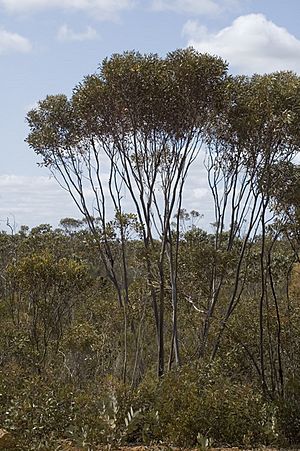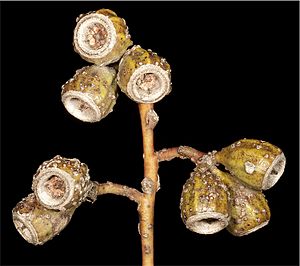Eucalyptus captiosa facts for kids
Quick facts for kids Eucalyptus captiosa |
|
|---|---|
 |
|
| Eucalyptus captiosa near Ravensthorpe | |
| Scientific classification | |
| Genus: |
Eucalyptus
|
| Species: |
captiosa
|
Eucalyptus captiosa is a special type of eucalyptus tree that grows only in the south-west part of Western Australia. It's known for its smooth bark, long, narrow leaves, and pale yellow flowers that grow in small groups. After flowering, it produces cup-shaped fruits. This plant is endemic, meaning it naturally lives only in this specific area of the world.
Contents
What Does Eucalyptus captiosa Look Like?
Eucalyptus captiosa is a type of mallee or mallet. These are terms for how the plant grows. A mallee usually has many stems growing from the ground, while a mallet is a small, single-stemmed tree. This plant typically grows to be about 1 to 4 meters (3 to 13 feet) tall.
It has smooth bark that can be grey, creamy white, or even coppery. Sometimes, you might see ribbons of bark that are partly peeling off.
- Leaves: Young plants and new shoots (called coppice regrowth) have leaves that are oblong or egg-shaped. These leaves are about 60 to 120 millimeters (2.4 to 4.7 inches) long and 20 to 37 millimeters (0.8 to 1.5 inches) wide. As the plant gets older, its adult leaves become thicker and more linear or narrow. They are usually 40 to 88 millimeters (1.6 to 3.5 inches) long and 5 to 13 millimeters (0.2 to 0.5 inches) wide. Each leaf has a small stalk, called a petiole, about 5 to 15 millimeters (0.2 to 0.6 inches) long.
- Flowers and Buds: The flower buds grow in groups of three or seven. They are found where the leaves meet the stem, which is called a leaf axil. These groups of buds grow on a stalk called a peduncle, which is about 8 to 15 millimeters (0.3 to 0.6 inches) long. Each individual bud also has a small stalk, a pedicel, about 2 to 6 millimeters (0.08 to 0.24 inches) long.
When the buds are ready to open, they are pear-shaped or oval. They are about 13 to 19 millimeters (0.5 to 0.7 inches) long and 5 to 7 millimeters (0.2 to 0.3 inches) wide. They usually have slight ribs and a beak-like cap, called an operculum, on top. Eucalyptus captiosa mainly flowers from July to November. Its flowers are a lovely cream color or pale yellow.
- Fruit: After the flowers bloom, they turn into a woody fruit. This fruit is a capsule, which is like a seed pod. It's shaped like a cylinder, barrel, or cup. The fruit is about 8 to 15 millimeters (0.3 to 0.6 inches) long and 8 to 11 millimeters (0.3 to 0.4 inches) wide. It sits on a pedicel, usually 2 to 7 millimeters (0.08 to 0.28 inches) long.
How Eucalyptus captiosa Got Its Name
The plant Eucalyptus captiosa was officially described for the first time in 1993. This was done by two scientists, Ian Brooker and Stephen Hopper. They published their description in a science journal called Nuytsia. They studied a sample of the plant found near Jerramungup.
The second part of its scientific name, captiosa, comes from a Latin word. It means "deceptive" or "misleading." This name was chosen because its fine, delicate leaves look very different from those of a related plant, E. incrassata. So, its appearance can be a bit "deceptive"!
Where Eucalyptus captiosa Grows
This eucalyptus plant grows in sandy and gravelly soils. You can find it in areas with heathland, which is a type of shrubland. It grows between the towns of Tambellup and Jerramungup in Western Australia. These areas are part of specific natural regions known as the Avon Wheatbelt, Esperance Plains, and Mallee biogeographic regions.
Is Eucalyptus captiosa Endangered?
The good news is that Eucalyptus captiosa is currently classified as "not threatened." This means that the Western Australian Government's Department of Parks and Wildlife believes there are enough of these plants in the wild, and they are not at risk of disappearing.



